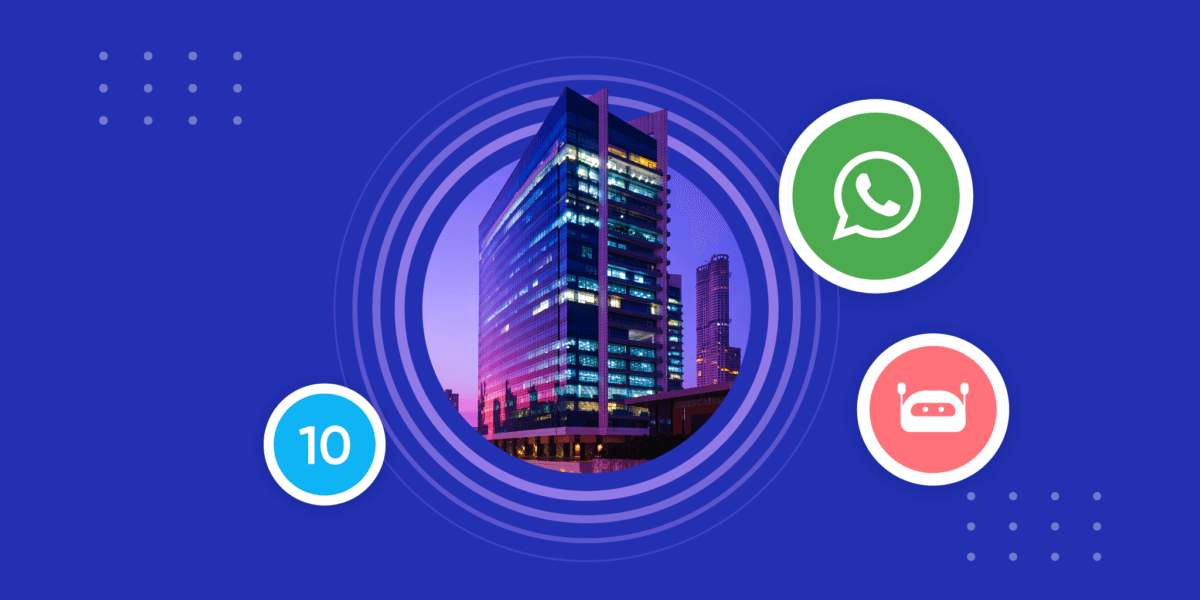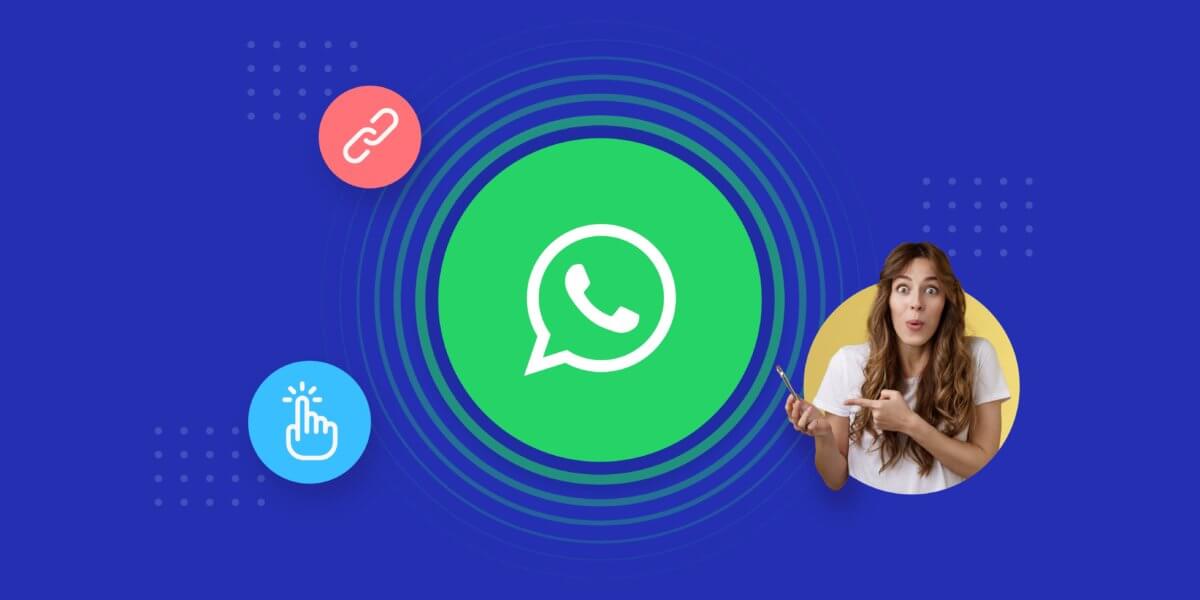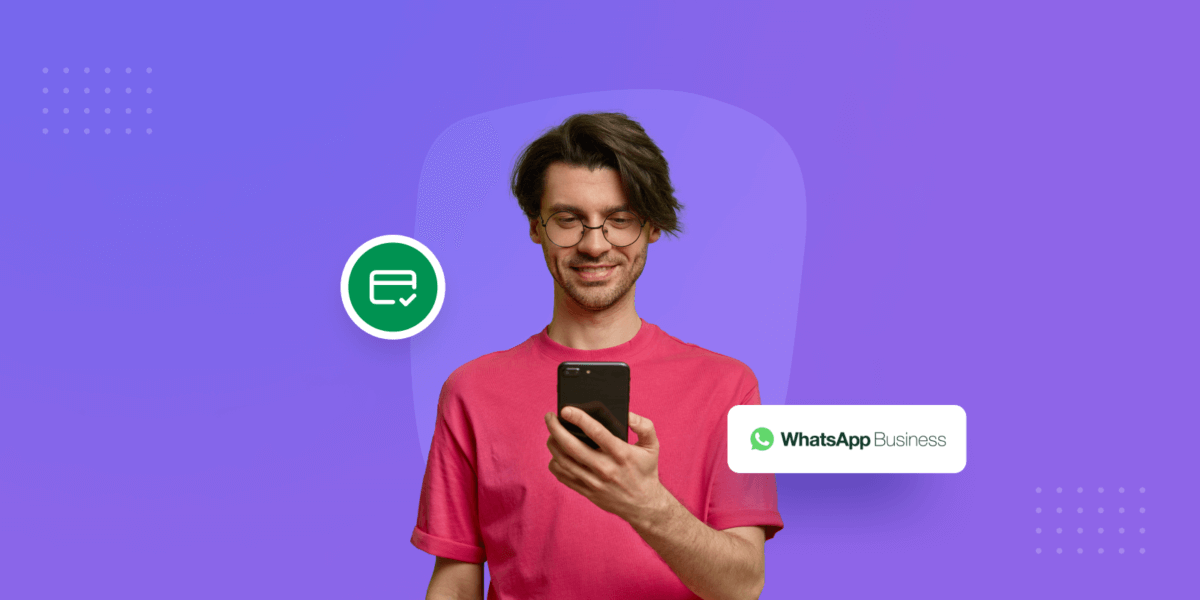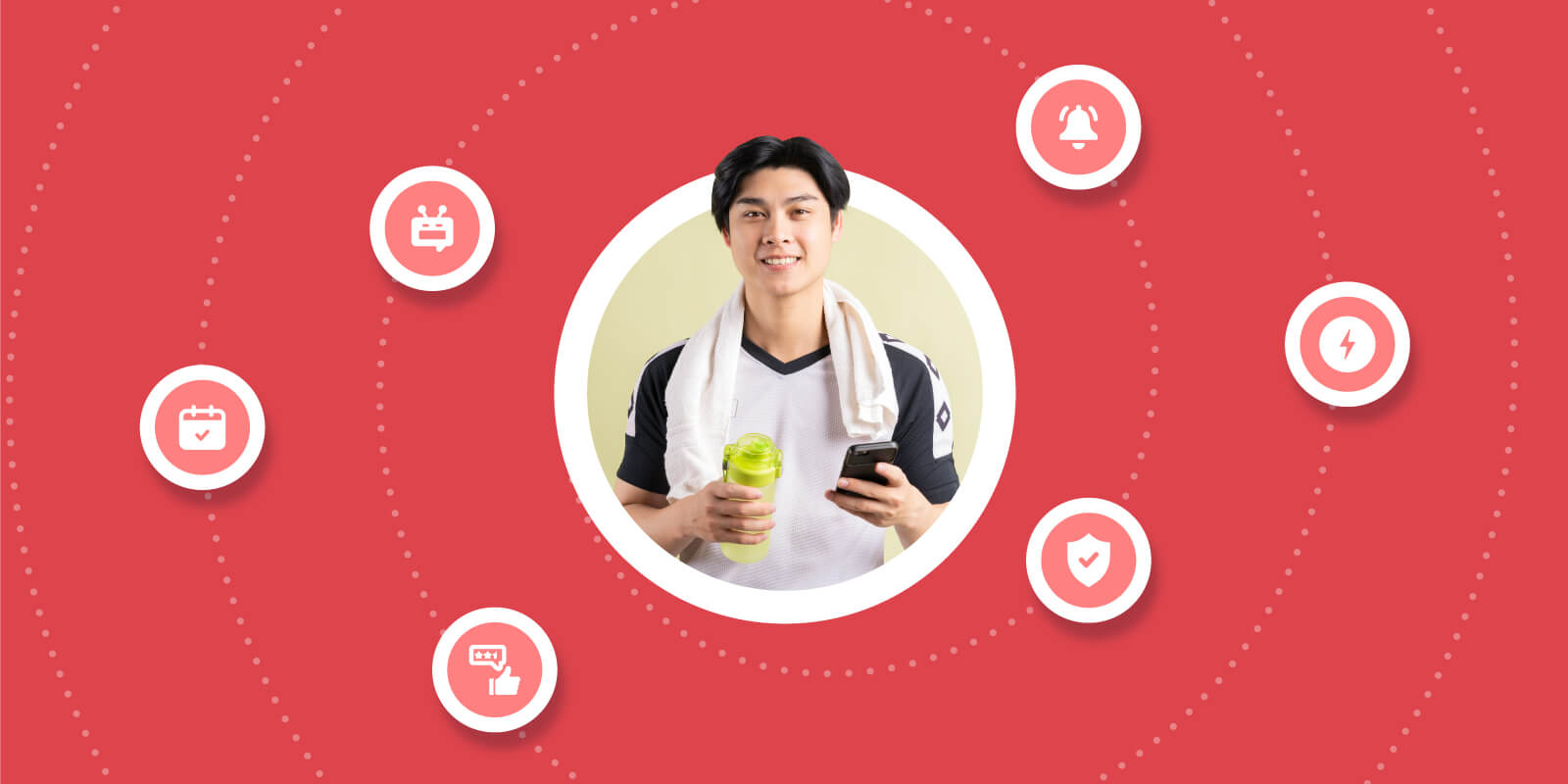Benefits of WhatsApp Chatbot: 10 Reasons Your Company Needs One Today!
- July 4th, 2025 / 5 Mins read
-
Aarti Nair

Benefits of WhatsApp Chatbot: 10 Reasons Your Company Needs One Today!
- July 4th, 2025 / 5 Mins read
-
Aarti Nair
With more than 3 billion people using WhatsApp every month, it’s become the world’s most ubiquitous messaging platform—one you simply can’t overlook when it comes to customer engagement. At the same time, 72 per cent of customers now expect an immediate response whenever they reach out via digital channels. In this landscape, a WhatsApp chatbot isn’t just “nice to have.” It’s essential if you want to meet your customers’ expectations and keep them coming back.
Let’s say you run a niche sportswear store and you’ve just launched a limited-edition running shoe at midnight. Within minutes, your customers flood your WhatsApp number with questions about sizing, delivery timelines and colour options—queries your small team simply can’t field outside office hours. Instead of missing out on those sales, a chatbot greets each visitor instantly, guiding them through a quick menu (“Select your size” → “Choose your preferred delivery slot”) and even pushing an automatic “Back in stock” notification when their chosen variant sells out. By the time your support team clocks in the next morning, the bot has already handled hundreds of enquiries, secured a slew of orders and neatly handed over the rest for any personal follow-up.
Every modern consumer has probably used a WhatsApp chatbot to connect with brands and resolve their queries at some point in time. The benefits of a WhatsApp chatbot are immense and companies have seen some incredible results. There are firms that have reduced their sales cycles from days to minutes. Some have achieved unparalleled reach. Like this leading bank, that used one to resolve every 8 in 10 queries with no human intervention!

So why do companies NEED a WhatsApp Business chatbot?
Why You Need a WhatsApp Chatbot
In 2025, WhatsApp will connect over 3.14 billion users worldwide, making it far and away the leading messaging platform for both consumers and businesses (demandsage.com). At the same time, modern customers have little patience for delayed replies. Without an always-on, automated solution, you risk losing enquiries (and sales) the moment your agents clock out.
Beyond speed, leading service-and-support teams are already harnessing conversational AI: by 2025, 80 per cent of customer service organisations will deploy generative-AI tools to boost agent productivity and enhance self-service options (apizee.com). A WhatsApp chatbot lets you tap straight into that power—automating routine requests, qualifying leads, sending order alerts and even handling simple returns, all without adding headcount. The result? Faster resolutions for your customers, lower operational costs for your business, and higher satisfaction scores across the board.
Ready to see exactly how?
In the next section, we’ll dive into 10 solid reasons your company needs a WhatsApp chatbot today.
10 benefits of using a WhatsApp chatbot for your business
From better visibility to better marketing, a WhatsApp chatbot has a lot to offer.
1. Wide reach on the world’s most popular chat app
WhatsApp is the world’s most popular messaging platform. Over 2.4 billion active customers talk to their friends and family every day. Even WhatsApp own numbers are enlightening. In 2021, the brand claimed that over 100 billion messages are exchanged daily on the platform.
Companies follow customers on to platforms – and there’s arguably none bigger today than WhatsApp. It is a household name. From children aged 5 to 80-year-old traditionalists, virtually almost everyone uses WhatsApp.
The app is famed for having one of the most intuitive and simplistic interfaces around. Hence, ensuring that all customers can use the platform to its fullest – without necessarily having to be technologically adept.
This makes for easy onboarding and improves user stickiness. In fact, this eCommerce brand used WhatsApp for this very reason. It was the most ideal app to ensure smooth user onboarding in rural India. With a WhatsApp chatbot, they were able to serve over 500,000 rural households in India!
2. 24×7 availability with high security
WhatsApp’s end-to-end encryption makes it one of the most secure platforms in the world.
WhatsApp end-to-end encryption ensures only you and the person you’re communicating with can read what’s sent, and nobody in between, not even WhatsApp.
Thus, making WhatsApp the ideal platform to send messages that contain sensitive information. OTPs, transactional updates, and follow-ups can all be sent using WhatsApp. And unlike conventional channels, the top benefit of WhatsApp chatbots is that they are available round-the-clock to assist users.
3. Omnipresence helps you build more visibility and better customer relationships
Customers that enjoy hurdle-free support experiences are more likely to purchase from the company again.
Companies need to be where customers are, whenever customers need them. With its 24/7 automation, a chatbot covers the “when”. And with its incredible market penetration, WhatsApp allows you to optimize for the “where”.
WhatsApp ensures that your brand and company are never more than a click away. You can create a WhatsApp click-to-chat link and direct your users to your WhatsApp number. Include it on your website home page or your email newsletter – a WhatsApp click-to-chat link ensures your users know how and where to reach you in times of need. Your products are easy to reach and your services are convenient to avail.
4. Quicker, more agile, easy FAQ solving
If you are a business, we know your users shower you with a plethora of doubts and questions every day. On refund and order statuses for eCommerce brands or on home loan applications for banks – users are always searching for answers. But for you, this is an everyday chore.
A WhatsApp chatbot takes all of that burden off of you. So, all your most common, recurring questions are easily addressed by a WhatsApp chatbot – during the day or at night!
But that’s just the beginning – Verloop.io allows companies to automate even more. Transpose data from your chatbot to a CRM/OMS system of your choice automatically. Use webhooks to pull data from your systems to seamlessly provide your customers with the necessary information.
5. Happy user experiences with approved high-quality message templates
Good conversational experience is paramount to WhatsApp. And the company does not budge on that! WhatsApp has always been maintained as a personal one-to-one chat app for its users. So, this means that brands are not allowed to send random, irrelevant messages that plummet the quality of user experiences you render.
This is why businesses that want to initiate chats with users must do so through message templates. These message formats must be approved by the WhatsApp team to ensure high-quality, relevance, and unambiguity of communication. You’d also like to read:
- The Perfect Recipe To Create Best WhatsApp Message Templates
- WhatsApp Templates: Download 30 WhatsApp Business API Templates
6. Personalisation with user data and rich media
Beyond the WhatsApp chatbot’s ease and portability, a well-built and trained chatbot can try to emulate natural conversations. During these interactions, the chatbot is able to collect and recall user data and context when it’s relevant. It offers a high level of personalisation as now each of your individual users’ needs and behaviour is easily mapped out and catered to by a chatbot that’s highly contextual in its responses.
Moreover, its media richness makes it a great platform for companies to interact with customers. Unlike email or phone support, WhatsApp allows brands to send photos, videos, gifs, voice recordings, and documents.
Verloop.io’s Outreach feature helps you get the most out of conversations with personalised campaigns and a lot more! Read more here:
7. Product range that’s accessible with ease
WhatsApp is turning out to be the Mecca of online shopping.
While conventional eCommerce allowed users to shop online, WhatsApp conversational commerce is an upgrade to the user experience. For example, the newly launched single and multiple product messages allow you to offer a product or display a catalogue of 30 products that are relevant to the user’s needs. Read: Get Started with WhatsApp Interactive Messages
With entry points planted at specific digital locations, you can drive users to your WhatsApp shop, converse and sell meaningfully, and offer post-purchase support – all on the same chat window!
As the Official Business Partner with WhatsApp, Verloop.io is helping build a cohesive and thriving conversational commerce space for modern users of the app!
If you aren’t sure how that happens, check out: WhatsApp Commerce: How WhatsApp Enables Complete User Journeys with The Power of Conversations!
8. Marketing and advertising that’s targeted and tailor-made
One thing we are all clear about by now is that a WhatsApp chatbot ensures your user experience game stays on top of the ladder. While WhatsApp previously prohibited businesses from sending any marketing content, the rules have changed since September 2021.
WhatsApp now lets businesses send message templates that are non-transactional, and purely promotional. But of course, this is subject to certain rules. To ensure a high degree of relevancy to the user, your WhatsApp chatbot can send templates that your users have explicitly opted-in to receive, are personalised and provide value to the user with a clear CTA.
Such relevant messaging ensures higher open rates, better CTRs, more conversions, and simply more ROI for you.
9. Performance that’s measurable, tangible, and consequently, actionable
A WhatsApp chatbot doesn’t just help you streamline communication at the front end. Another benefit of a WhatsApp chatbot is that gives you a peek into your team’s performance.
For example, Verloop.io’s smart dashboard helps you visualise your chatbot and your support agent’s performance from a single vantage point. Track metrics like your first and average response time, resolution rate and time, and customer satisfaction score. You can find out the most common lags that need fixing and process gaps that need to be filled.
Best WhatsApp chatbots not only let you connect with users but also how to do it better in future with AI-driven actionable insights.
10. Faster, smarter agent routing
The problem with the unmanned channels/tools brands use is that human intervention never comes quickly enough. An email thread needs hours to rope the right department/agent in.
But, with a WhatsApp Business chatbot, however, humans can seamlessly and instantaneously pick up chats from the bot. This empowers agents to deliver excellent customer service, without having to work through thousands of monotonous chats. Read: Introducing Agent Skills for Smart Routing and Quick Support
Suggested Reading:
- How to create WhatsApp Business Account
- WhatsApp Bot: A Guide for India in 2022
- All You Need To Know About WhatsApp Business Pricing In 2022
- 21 Most Frequently Asked Questions On WhatsApp Business
Further Reading: WhatsApp Chatbot for Business:
WhatsApp Chatbot Use Cases
Below are some of the most impactful ways you can deploy a WhatsApp chatbot—and real-world examples to spark your imagination.
-
Always-on customer support
Imagine a shopper browsing late at night who needs to know if the new running jacket is water-resistant. Instead of waiting until your team logs on, your chatbot can jump in immediately:
Customer: “Is the AeroRun jacket suitable for rainy runs?”
Bot: “Absolutely—it’s rated IPX4 for splash resistance. Would you like care instructions or sizing info?”
-
Real-time order updates
Rather than leaving customers guessing, your bot can push automatic alerts the moment an order ships, is out for delivery or encounters a delay:
Bot: “Good news! Your order #4523 has just left our warehouse and will arrive tomorrow by 2 pm.”
-
Quick lead qualification and booking
When a prospect messages saying “I need help with a new website,” your chatbot can gather essential details and lock in a call—no back-and-forth emails required:
Bot: “Great! What’s your ideal launch timeframe?”
Customer: “Within the next eight weeks.”
Bot: “Perfect—here’s a link to book a 15-minute discovery call with our web team.”
-
Personalised product suggestions
By tapping into past orders or preferences, the bot can feel like a personal shopper, recommending items your customer will love:
Customer: “I’m looking for noise-cancelling headphones.”
Bot: “Based on your last purchase, I recommend the SoundWave Pro. Want to see specs or add to cart?”
-
Seamless feedback and surveys
Right after delivery or a support interaction, the chatbot can send a two-tap survey that feels natural in WhatsApp—boosting your response rates:
Bot: “On a scale of 1–5, how satisfied are you with your recent order?”
-
Multilingual conversations
Whether your customer prefers English, Hindi or Arabic, the chatbot can switch on the fly, making support feel local:
Customer: “क्या ये शूज़ लाइटवेट हैं?”
Bot: “हाँ, ये केवल 250 ग्राम हैं—आपको और जानकारी चाहिए?”
These fluid, chat-first interactions not only save your team countless hours but also elevate the customer experience to keep enquiries moving and conversions climbing without adding headcount.
Implementation Best Practices for WhatsApp Chatbot
When you’re ready to roll out a WhatsApp chatbot, following these best practices will ensure a smooth launch and ongoing success.
Choose the right platform
Decide early whether you need an on-premise solution—where you host the chatbot software in your own data centre—or a cloud-based service managed by the vendor.
-
On-premise can offer tighter control over data and custom integrations, which is ideal if you have strict security or compliance mandates.
-
Cloud-based platforms, by contrast, are faster to deploy and scale automatically during peak traffic, with less operational overhead.
Weigh your in-house technical expertise and data-sovereignty requirements against your need for flexibility and speed.
Design your chat flow with UX in mind
A well-crafted conversation keeps customers moving forward without friction. Start by mapping the most common enquiries, then build simple decision trees that guide users step by step.
-
Use clear prompts: Offer quick-reply buttons (e.g. “Track Order,” “Speak to Agent”) instead of relying on free-text whenever possible.
-
Anticipate errors: When a user’s reply doesn’t match any option, the bot should apologise briefly and offer a fallback—either a “Try again” prompt or a live-agent handover.
-
Keep it concise: Break lengthy messages into bite-sized chunks. If you must ask multiple questions, group them logically and confirm responses before moving on.
Ensure compliance and opt-in management
WhatsApp’s Business API requires explicit user consent before sending non-transactional messages. To stay on the right side of GDPR, PDPA and other data-privacy laws:
-
Capture consent at the first touchpoint—include a checkbox or clear “Yes, I agree” button when users subscribe to your WhatsApp updates.
-
Document opt-ins centrally so you can audit who agreed, when and under what terms.
-
Respect message templates: Use pre-approved, template-based notifications for promotional content, and avoid unsolicited broadcasts.
-
Offer easy opt-outs: Every bot-initiated message should include a simple “Reply STOP to unsubscribe” instruction, and process removals promptly.
By carefully selecting your deployment model, crafting intuitive chat experiences and rigorously managing consent, you’ll set your WhatsApp chatbot up for both operational efficiency and regulatory peace of mind.
V. Measuring Success
To ensure your WhatsApp chatbot delivers real value, you need to keep a close eye on performance and then iterate based on hard data.
Key metrics to track
-
Average response time: Aim for under 30 seconds between a user message and the bot’s reply. Faster responses build trust and keep conversations moving.
-
Customer satisfaction (CSAT): Embed a simple 1–5 rating at the end of each chat. If your CSAT dips below 4.0, review the scripts and handover points.
-
Conversion rate: Measure the percentage of chat sessions that result in a desired action—whether that’s a sale, a booked appointment or a support ticket resolution. Even a 5 % uplift can justify your investment.
-
Deflection rate: Track how many queries the bot resolves without needing human intervention. Higher deflection frees your agents for more complex issues.
-
Opt-in and opt-out rates: Keep tabs on how many users subscribe or unsubscribe from your messages—this flags if you’re over-messaging or failing to deliver value.
A/B testing your bot scripts
Just like email campaigns, your chatbot copy benefits from experimentation. Split your audience and test variations of:
-
Welcome messages: Try “Hi Alice! How can I help today?” versus “Hello there! What would you like to do?”
-
Quick-reply options: Compare two sets of buttons (e.g. “Track Order / Talk to Agent” vs. “Order Status / Live Support”) to see which leads to higher engagement.
-
Call-to-action phrasing: “Book your demo now” might outperform “Schedule a demo” by making the next step clearer.
Run each test for at least a week or until you have a statistically significant sample. Then promote the winning script and iterate on the next element. By continuously measuring and refining, you’ll keep your chatbot performing at its best and driving real business results.
Deploy Your WhatsApp Chatbot Today
Remember that late-night jacket launch we imagined, when your chatbot quietly slipped in to answer “Is it water-resistant?” while your team slept?
That single interaction captures the true power of a WhatsApp bot: it never clocks out, it speaks your customers’ language, and it nudges prospects gently toward the sale, all without adding headcount.
Picture this: your busiest season rolls around, and instead of scrambling to scale support desks, your bot guides shoppers through order updates, upsells with personalised suggestions and even books follow-up calls with your sales team. Meanwhile, you’re free to focus on high-impact tasks—product launches, creative campaigns or simply catching a well-earned break.
If you’re ready to see those seamless conversations in action, let’s make it happen. Book a demo to explore a tailored WhatsApp chatbot for your business or launch a free pilot and watch your first round-the-clock chat take shape today.

FAQ Section
1. What is a WhatsApp chatbot and how does it differ from a regular chatbot?
A WhatsApp chatbot is a conversational bot built on the WhatsApp Business API. Unlike standalone chatbots on websites or apps, it lives within WhatsApp—a channel your customers already use daily. This means instant familiarity, higher open rates and the ability to send template-based notifications (e.g. order updates) that regular chatbots can’t.
2. Can I use WhatsApp Business API with any CRM?
Most leading CRMs—Salesforce, HubSpot, Microsoft Dynamics 365 and others—offer native or third-party integrations with the WhatsApp Business API. These connectors synchronise chat transcripts, contact records and campaign data, so you can view every interaction and trigger workflows directly from your CRM dashboard.
3. How much does implementing a WhatsApp chatbot typically cost?
Costs vary based on message volume, chosen platform and customisation level. You’ll usually pay:
-
A WhatsApp API fee per template message (set by WhatsApp/Meta)
-
A monthly subscription for the chatbot vendor (often tiered by number of active users or messages)
-
Professional services if you need bespoke integrations or conversational design
As a ballpark, many SMEs break even within three to six months thanks to reduced support costs and higher conversions.
4. What languages can the chatbot support?
WhatsApp chatbots can be trained or configured to converse in any language supported by your chosen platform. Popular options include English, Spanish, Arabic, Hindi and Portuguese, but you can add virtually any language—provided you supply the translation for message templates and training data for AI-powered bots.
5. How secure is customer data on WhatsApp?
WhatsApp employs end-to-end encryption for all messages, meaning only the sender and recipient can read the content. On the API side, reputable vendors follow strict security standards (ISO 27001, SOC 2) and provide data-residency options where required. To maintain compliance, always choose a platform that guarantees encrypted storage and controlled access to chat logs.







